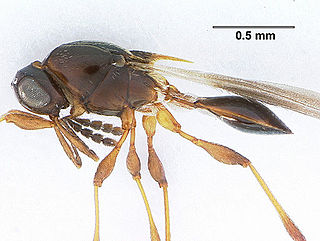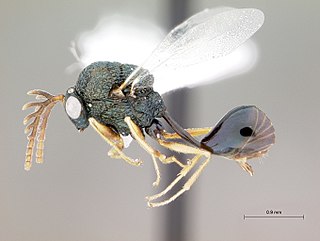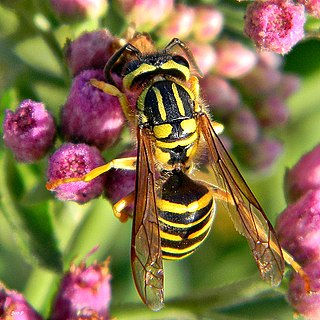Related Research Articles

In evolutionary ecology, a parasitoid is an organism that lives in close association with its host at the host's expense, eventually resulting in the death of the host. Parasitoidism is one of six major evolutionary strategies within parasitism, distinguished by the fatal prognosis for the host, which makes the strategy close to predation.

The family Agaonidae is a group of pollinating and nonpollinating fig wasps. They spend their larval stage inside the fruits of figs. The pollinating wasps are the mutualistic partners of the fig trees. The nonpollinating fig wasps are parasitic. Extinct forms from the Eocene and Miocene are nearly identical to modern forms, suggesting that the niche has been stable over geologic time.

The Braconidae are a family of parasitoid wasps. After the closely related Ichneumonidae, braconids make up the second-largest family in the order Hymenoptera, with about 17,000 recognized species and many thousands more undescribed. One analysis estimated a total between 30,000 and 50,000, and another provided a narrower estimate between 42,000 and 43,000 species.

The Hymenopteran superfamily of parasitoid wasps, Platygastroidea, has often been treated as a lineage within the superfamily Proctotrupoidea, but most classifications since 1977 have recognized it as an independent group. It is presently composed of one extinct and three extant families, with some 4000 described species. They are exclusively parasitic in nature.

Commonly known as cuckoo wasps or emerald wasps, the hymenopteran family Chrysididae is a very large cosmopolitan group of parasitoid or kleptoparasitic wasps, often highly sculptured, with brilliant metallic colors created by structural coloration. They are most diverse in desert regions of the world, as they are typically associated with solitary bee and wasp species, which are also most diverse in such areas. Their brood parasitic lifestyle has led to the evolution of fascinating adaptations, including chemical mimicry of host odours by some species.

The Eucharitidae are a family of parasitic wasps. Eucharitid wasps are members of the superfamily Chalcidoidea and consist of three subfamilies: Oraseminae, Eucharitinae, and Gollumiellinae. Most of the 55 genera and 417 species of Eucharitidae are members of the subfamilies Oraseminae and Eucharitinae, and are found in tropical regions of the world.

The Evaniidae, also known as the ensign wasps, nightshade wasps or hatchet wasps, are a family of parasitic wasps. They number around 20 extant genera containing over 400 described species, and are found all over the world except in the polar regions. The larvae of these solitary wasps feed on cockroaches, and develop inside the egg-cases (oothecae) of their hosts.

A wasp is any insect of the narrow-waisted suborder Apocrita of the order Hymenoptera which is neither a bee nor an ant; this excludes the broad-waisted sawflies (Symphyta), which look somewhat like wasps but are in a separate suborder. The wasps do not constitute a clade, a complete natural group with a single ancestor, as their common ancestor is shared by bees and ants. Many wasps, those in the clade Aculeata, can sting their insect prey.

Neanaperiallus is an extinct monotypic genus of parasitic wasp in the Eupelmidae subfamily Neanastatinae containing only a single species, Neanaperiallus masneri. The genus is solely known from the Early Eocene Baltic amber deposits in the Baltic Sea region of Europe.
Labenopimplinae are an extinct subfamily of the parasitic wasp family Ichneumonidae. Labenopimplinae are known from the Cenomanian of the Russian Far East and Turonian of Orapa, Botswana. The subfamily includes five genera with 13 species. The subfamily is highly polymorphic and combines features of the Labeninae and Pimplinae.
Dinocampus coccinellae is a braconid wasp parasite of coccinellid beetles, including the spotted lady beetle, Coleomegilla maculata. D. coccinellae has been described as turning its ladybird host into a temporary "zombie" guarding the wasp cocoon. About 25% of Coleomegilla maculata recover after the cocoon they are guarding matures, although the proportion of other ladybird species which recover is much lower.

The Euphorinae are a large subfamily of Braconidae parasitoid wasps. Some species have been used for biological pest control. They are sister group to the Meteorinae.

Vespula squamosa, the southern yellowjacket, is a social wasp. This species can be identified by its distinctive black and yellow patterning and orange queen. These yellowjackets are typically found in eastern North America, and its territory extends as far south as Central America. Within these territories, they create enormous, multiple-comb nests. The colonies may be either annual or perennial depending on the climate, and in many perennial nests, polygyny takes place. In addition, this species uses pheromones both as a sexual attractant and an alarm signal. This species feeds on insects and animal carcasses; it does not produce honey. V. squamosa, a social insect, has developed a parasitic relationship with the species V. vidua and V. maculifrons. Due to their painful, venomous stings, the species is considered a pest.

Meteorus is a genus of parasitoid wasps in the family Braconidae. It comprises over 330 species worldwide.
Chrysopophthorus is a genus of wasps in the family Braconidae.
Euphorini is a tribe of braconid wasps in the subfamily Euphorinae.

Tetraschininae is a subfamily of the chalcid wasp family Eulophidae. It is one of the largest subfamilies of the Eulophidae containing over 100 genera and nearly 3,000 species. The species of the family Tetrastichinae are found in almost any type of terrestrial habitat and have a worldwide distribution, except Antarctica. They show a varied biology and hosts for Tetraschine wasps have been identified from over 100 different insect families, across 10 different orders and they have also been recorded as being parasitoids on nematodes, mites and spiders' eggs. Some species are even phytophagous, while others are inquilines and yet others are gall formers.
Hybrizon is the only extant genus in the subfamily Hybrizontinae of ichneumonid parasitoid wasps. The subfamily was previously called Paxylommatinae, and has in the past been considered part Braconidae, or a separate family altogether.
Syntretus is a genus of parasitic wasps of adult bumblebees.

Meteorinae is a subfamily of braconid parasitoid wasps. Several species have been used in biological control programs. The name for this group comes from the pupal stage, which, in species attacking Lepidopteran hosts, hangs suspended from a long thread of silk.
References
- ↑ A new braconid genus (Hymenoptera) parasitizing webspinners (Embiidina) in Trinidad. SR Shaw, JS Edgerly, Psyche: A Journal of Entomology, 1985
- Phylogeny of the parasitic wasp subfamily Euphorinae (Braconidae) and evolution of its host preferences. doi : 10.1111/syen.12122
-
 Data related to Syntretini at Wikispecies
Data related to Syntretini at Wikispecies
| | This Ichneumonoidea-related article is a stub. You can help Wikipedia by expanding it. |